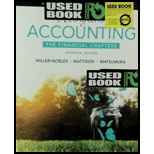
Concept Introduction:
Relevant or avoidable costs and Irrelevant or unavoidable costs –
The major decisions that a business has to take during its operations include dropping of a product, elimination of a segment, buy or make a product, to sell at scrap or rework on the product, to accept special offers etc. All these decisions are taken on the basis of the costs involved. There are two types of costs –
1. Relevant costs or avoidable costs – these costs can be defined as the costs that can be avoided if we choose over option over the other. Example of relevant costs are, direct material, direct labor, avoidable fixed costs etc.
2. Irrelevant costs – these costs can be defined as the costs that cannot be avoided in any of the options available or the costs which have been already incurred like sunk costs. Examples of irrelevant costs are unavoidable fixed costs, or the costs which have been already incurred.
Requirement 1
To identity:
Each cost in the income statement as either relevant or irrelevant to Deep Blue’s decision.
Requirement 2
To prepare:
A differential analysis to determine whether Deep Blue should accept this special sales order or not
Requirement 3
To identity:
Long-term factors to be considered in deciding whether to accept the special sales order or not.
Want to see the full answer?
Check out a sample textbook solution
Chapter 25 Solutions
Horngren's Accounting, The Financial Chapters (11th Edition) - Standalone Book
- Bayshore Equipment Co. reports that its manufacturing overhead is 60% of its total conversion costs. If direct labor is $52,000 and direct materials are $34,000, what is the manufacturing overhead?arrow_forwardSameer sells a product for $75 per unit and has a contribution margin ratio of 40%. Fixed expenses total $180,000 annually. How many units must be sold to yield a profit of $60,000?arrow_forwardPlease provide the correct answer to this general accounting problem using accurate calculations.arrow_forward
- I need guidance on solving this financial accounting problem with appropriate financial standards.arrow_forwardCould you help me solve this financial accounting question using appropriate calculation techniques?arrow_forwardCan you solve this financial accounting problem using appropriate financial principles?arrow_forward

 AccountingAccountingISBN:9781337272094Author:WARREN, Carl S., Reeve, James M., Duchac, Jonathan E.Publisher:Cengage Learning,
AccountingAccountingISBN:9781337272094Author:WARREN, Carl S., Reeve, James M., Duchac, Jonathan E.Publisher:Cengage Learning, Accounting Information SystemsAccountingISBN:9781337619202Author:Hall, James A.Publisher:Cengage Learning,
Accounting Information SystemsAccountingISBN:9781337619202Author:Hall, James A.Publisher:Cengage Learning, Horngren's Cost Accounting: A Managerial Emphasis...AccountingISBN:9780134475585Author:Srikant M. Datar, Madhav V. RajanPublisher:PEARSON
Horngren's Cost Accounting: A Managerial Emphasis...AccountingISBN:9780134475585Author:Srikant M. Datar, Madhav V. RajanPublisher:PEARSON Intermediate AccountingAccountingISBN:9781259722660Author:J. David Spiceland, Mark W. Nelson, Wayne M ThomasPublisher:McGraw-Hill Education
Intermediate AccountingAccountingISBN:9781259722660Author:J. David Spiceland, Mark W. Nelson, Wayne M ThomasPublisher:McGraw-Hill Education Financial and Managerial AccountingAccountingISBN:9781259726705Author:John J Wild, Ken W. Shaw, Barbara Chiappetta Fundamental Accounting PrinciplesPublisher:McGraw-Hill Education
Financial and Managerial AccountingAccountingISBN:9781259726705Author:John J Wild, Ken W. Shaw, Barbara Chiappetta Fundamental Accounting PrinciplesPublisher:McGraw-Hill Education





